Can carbon capture free the world from CO₂?
Can we limit global warming to 1.5 degrees? As carbon dioxide (CO₂) emitters, humanity is without rival. Staggeringly, over half of the CO₂ released in the last 300 years has been added since 1980[1]. Fortunately, we’re also getting better at removing it. That’s just as well because it will take decades to decarbonize by cutting emissions alone.
Could carbon capture and storage be the answer to a shorter-term solution?
What is carbon capture and storage?
Carbon Capture and Storage (CCS) captures CO₂ emitted by industrial processes and power generation. The CO₂ is compressed, transported, and stored in underground rock formations. Carbon Capture, Utilization, and Storage (CCUS) converts the CO₂ into commercially viable products.
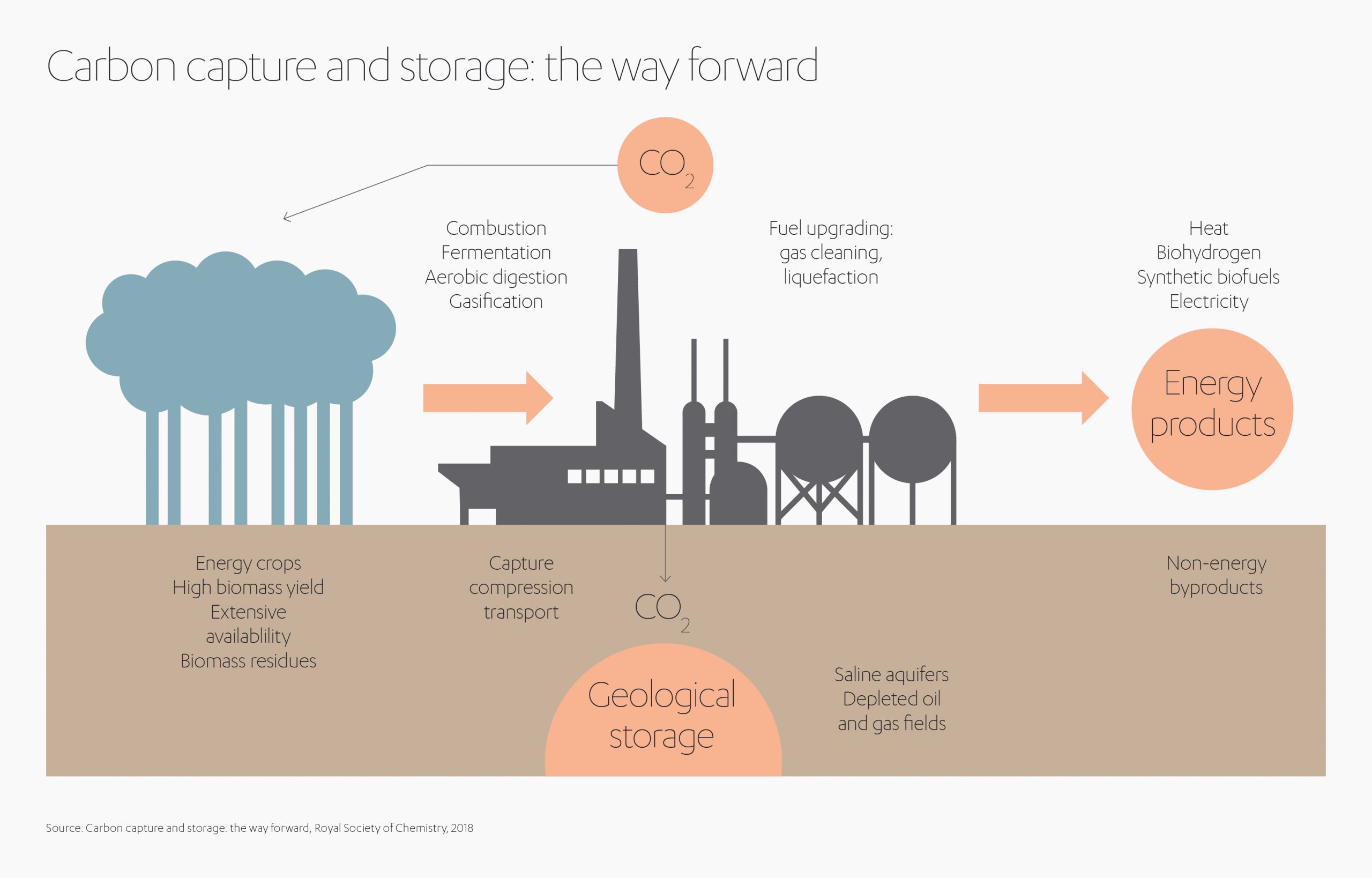
According to a report from the International Energy Agency (IEA), “Carbon capture, utilization and storage (CCUS) is the only group of technologies that contributes both to reducing emissions in key sectors directly and to removing CO₂ to balance emissions that are challenging to avoid – a critical part of net-zero goals.”
 Carbon capture is a proven technology that has been in operation for almost 50 years.
Carbon capture is a proven technology that has been in operation for almost 50 years.
But it’s woefully underused.
According to the Global CCS Institute’s 2019 report, there were just 51 CCS facilities globally, only 19 of which were in operation. The majority are in the United States and Canada, with the remainder in Europe and Asia. There are just two CCUS-equipped power plants, both of which are in North America.
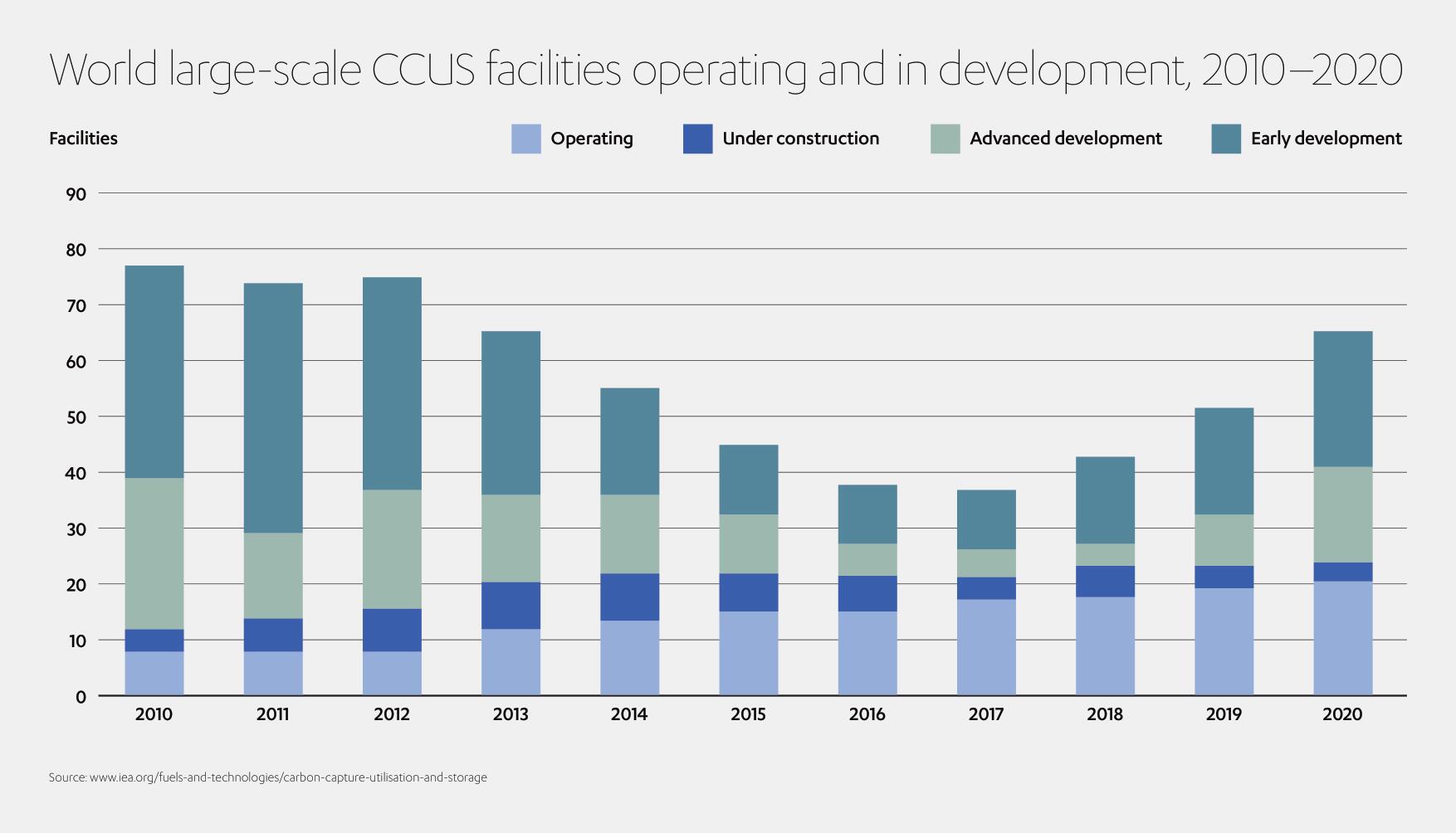
Commercial uses for CO₂
Most CCUS projects sell CO₂ to oil companies for Enhanced Oil Recovery (EOR). CO₂ can also be used to produce synthetic fuels, chemicals, building materials, pharmaceuticals, water treatment, and, of course, carbonated drinks. New or growth markets could include the use of CO₂ as a feedstock or as working fluid in some processes (including in power generation), conversion to polymers or carbonates, concrete curing, and mineral carbonation.
Focusing on the biggest emitters
As discussed in the Spotlight article on decarbonization by Abdul Latif Jameel’s Deputy Chairman and Vice President, Fady Jameel, carbon capture is vital to achieving net-zero emissions – and one of the cheapest ways to achieve it at current commodities prices. The IEA believes CCUS is one of four key pillars in the global energy transition, alongside renewable electricity, bioenergy, and hydrogen[2].
The four main uses for carbon capture are:
- Decarbonizing heavy industry:
Heavy industry accounts for over 20% of global CO₂ emissions[3], a topic explored in more depth in our Perspectives article on decarbonizing industry. Unfortunately, it’s often technically tricky or too costly to reduce carbon emissions in manufacturing products like steel, chemicals, and cement. These processes rely on intense heat where renewable electricity can’t yet compete with fossil fuels[4]. In lieu of alternatives, carbon capture is essential. CCUS is also the only solution for processing natural gas, which contains large amounts of CO₂ that must be removed before use.
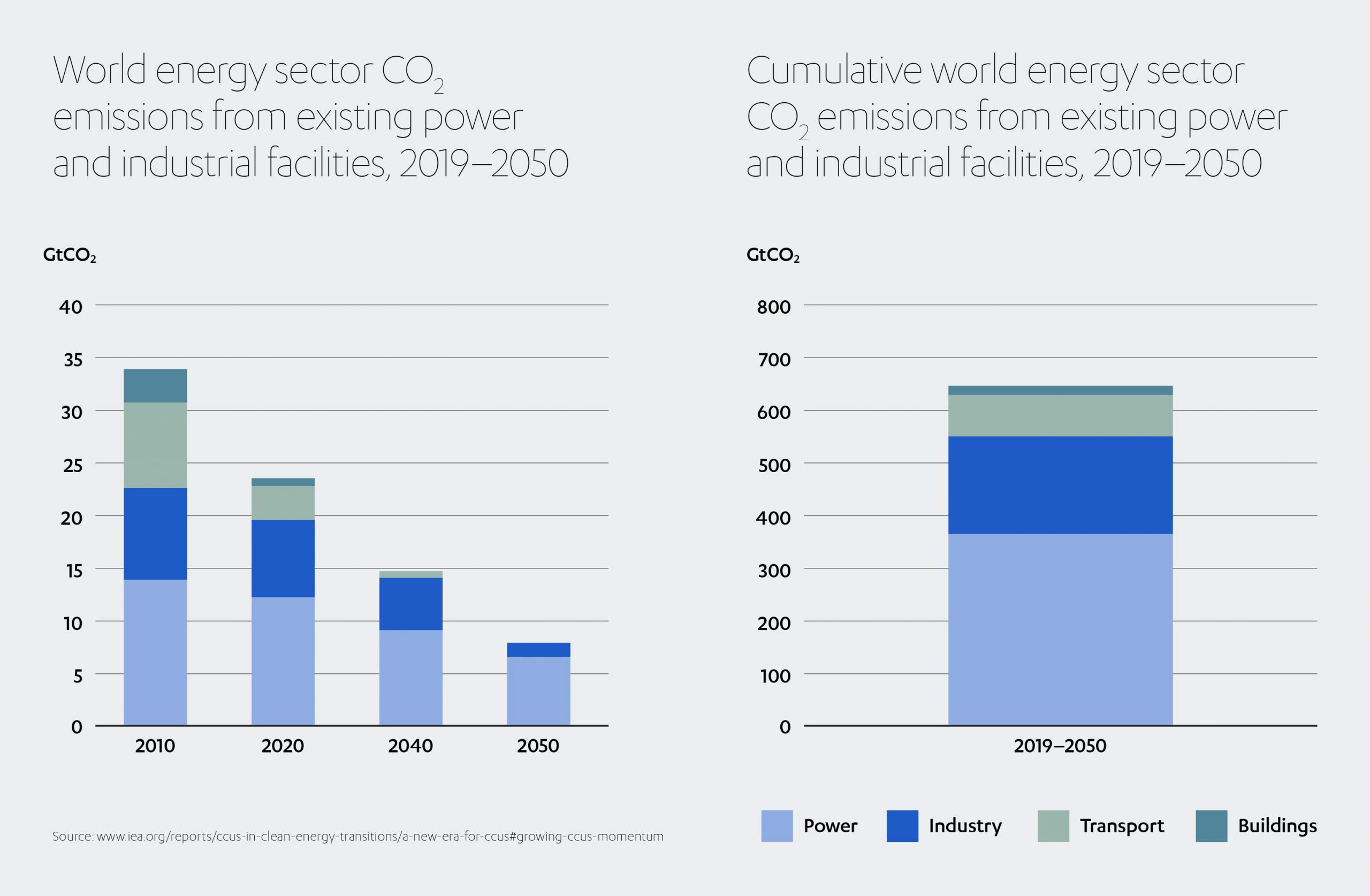
- Retrofitting existing facilities:
Without modifications, today’s power stations and industrial plants could generate nearly two decades worth of CO₂ (600 GtCO₂) during their remaining lifespans. Coal power stations, in particular, accounted for almost one-third of global CO₂ emissions in 2019 — and up to 60% could still be operation in 2050.[5] Steel isn’t much better. CCUS is the only way these plants can maintain their current output—and protect local economies — while dramatically reducing emissions.
- Creating low-carbon hydrogen fuel:
CCUS provides a cost-effective way to produce hydrogen, a clean-burning gas that can replace fossil fuels in the power, transport, industry, and built environment sectors. Hydrogen’s energy density makes it a viable alternative to fossils fuels in aviation. (The only other option is sustainable biomass, but there’s not a huge supply.)
- Pulling carbon out of the air:
It’s tricky to capture carbon from some processes. Fortunately, CO₂ can be extracted from the air, either trapping it within sustainable biomass or using direct air capture and storage. These are increasingly popular options for businesses seeking to offset historical emissions. Shopify, Canada’s largest company, recently announced it would capture 10,000 metric tons of CO₂[6].
Cheaper, but not cheap enough?
As the IEA highlights, reducing emissions will be prohibitively expensive without carbon capture. In a report on the cost of carbon capture, it states:
“Limiting the availability of CCUS would considerably increase the cost and complexity of the energy transition by increasing reliance on technologies that are currently more expensive and at earlier stages of development. One such example is the electrification of very high-temperature heat furnaces used for cement production and virgin steelmaking.[7]”
However, CCUS isn’t cheap. Significant upfront investment is required to upgrade or retrofit facilities and establish transport and storage infrastructure. Oversized facilities provide the best economies of scale but are more expensive to commission; it can be difficult to secure financing and share commercial risk across projects, (and anything that erodes margins is a problem for keenly priced commodities like steel).
Carbon capture is often seen as legitimizing fossil fuels, which, coupled with the dramatic fall in wind and solar power prices, can make the technology less attractive to industry and the public. Then there’s the ‘chicken-and-egg’ scenario to overcome: there’s no point capturing CO₂ unless there’s somewhere to store it. And there’s no point investing in storage without a supply of CO₂. To make matters worse, COVID-19 and the resulting economic downturn have impacted investment and reduced the demand for CO₂ in enhanced oil recovery, currently the biggest revenue source for CCUS.
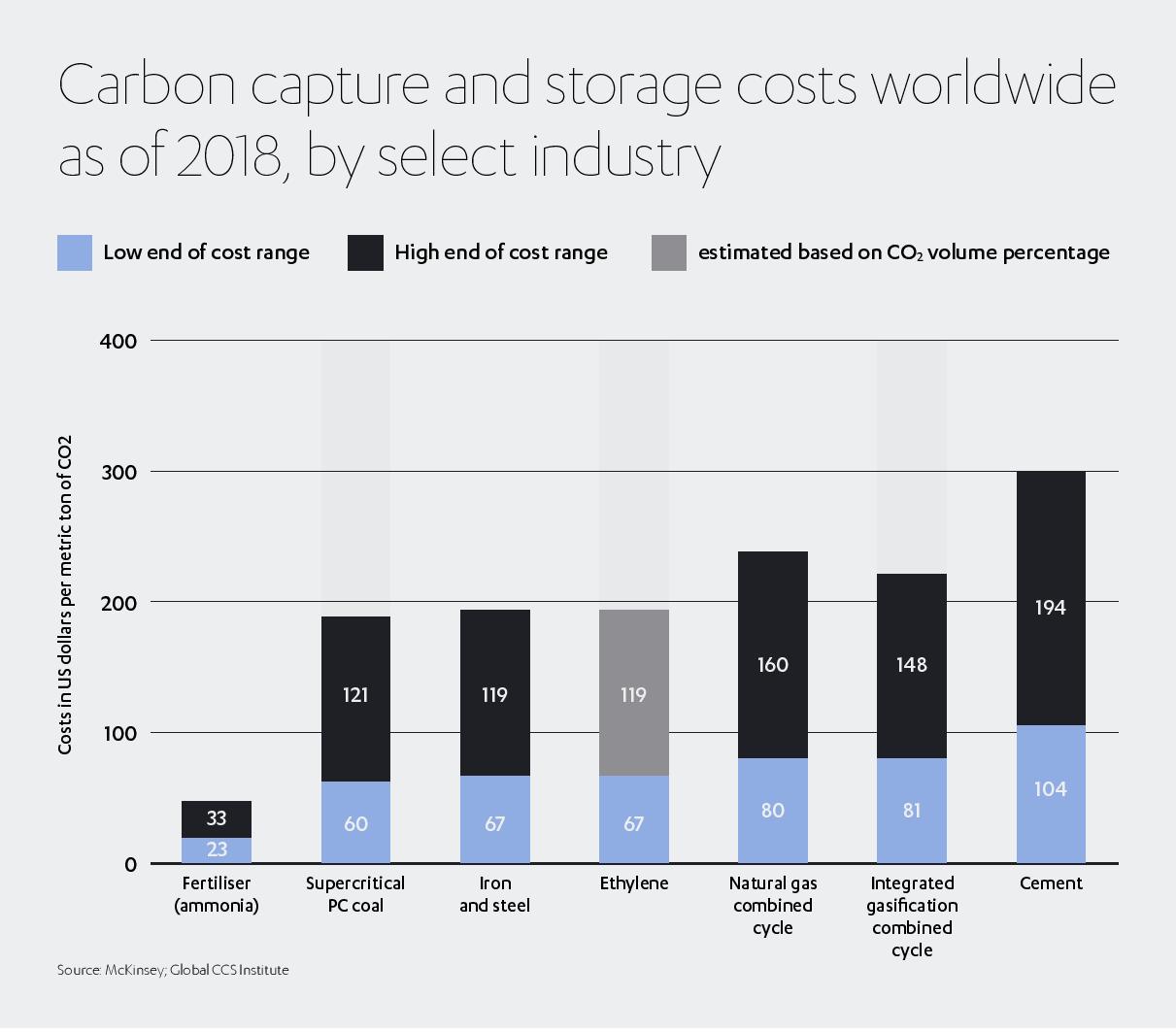
All of these challenges are compounded by the need to move fast to hit emissions reduction targets. So, is a massive scale-up of carbon capture even feasible?
Government to the rescue
Some challenges can’t be overcome by markets alone. CCUS has never exceeded 0.5% of global investment in clean energy and efficiency technology[8]. Urgent government action is essential to support the carbon capture market and dramatically increase the number of facilities. There is no one-size-fits-all solution, but governments can draw on a combination of measures to support innovation and ramp up carbon capture operations, including grants, tax credits, carbon pricing, subsidies, regulation, and public procurement of low-carbon products from CCUS plants.
We’re seeing progress. In particular, the increasing adoption of net-zero emissions targets is helping to reinforce the case for carbon capture. As of August 2020, 14 countries and the EU had adopted or proposed zero-emissions targets – with 100 other countries preparing to follow suit[9]. Various policy incentives are also making carbon capture more financially viable. In the US, the expanded 45Q tax credit (introduced in 2018) provides attractive incentives for CO₂ stored or used in EOR[10]. The EU Innovation Fund makes billions of euros available to support CCUS and other clean energy projects from 2020[11].
According to the IEA, governments and industry committed more than US$ 4.5 billion to CCUS in 2020, despite the COVID-19 pandemic.[12] 30 CCUS facilities have been announced since 2017 – worth around US$ 27 billion. Most are in the United States and Europe, but others are in Australia, China, Korea, the Middle East, and New Zealand. According to the IEA, if all these projects proceed, the amount of global CO₂ capture capacity would more than triple, to around 130 Mt per year[13].
Innovation and investment
In addition to government support, private investment and R&D are helping to make carbon capture a more commercially attractive proposition:
Falling costs: There are just two commercial coal plants with carbon capture, but the difference between them highlights the cost-saving potential of innovation. Carbon capture is 30% cheaper at Houston’s Petra Nova plant, commissioned in 2017, compared to Canada’s Boundary Dam facility, which has been in operation since 2014. However, at US$ 65/t, it’s still relatively expensive to what’s now possible. According to the International CCS Knowledge Centre, retrofitting a coal-fired power plant today could cost around US$ 45/t. This is likely to increase the more there are. Up to 10 coal power plants are planned for retrofit across China, Korea, and the US.
More investment and incentives: According to the IEA, “global private funding for CO₂ use start-ups reached nearly US$ 1 billion over the last decade”. Competitions like the NRG COSIA Carbon XPrize are incentivizing innovative CO₂ conversion technologies and CO₂ use applications.
More research in Direct Air Capture technology (DAC): There are several small-scale DAC facilities currently in operation and more on the way. Leading developers have raised around US$ 180 million of private capital and over US$ 170 million in public funding for research and development into DAC technology. The Swiss company, Climeworks, is currently expanding its Direct Air Capture with Carbon Storage (DACCS) plant in Iceland, which will capture thousands of tons of CO₂ per year as part of the CarbFix2 project[14].

In Texas, Carbon Engineering has partnered with Occidental Petroleum to build a CCUS plant that will capture around one million tons of CO₂ per year and use it for enhanced oil recovery.[15].
The bigger, the better
For carbon capture to make commercial sense and ramp up rapidly, it needs extensive shared infrastructure. Around 12 such ‘CCUS hubs’ are currently in development in Australia, Europe, and the US, many of which are linked to low-hydrogen production.
CCUS hubs reduce commercial and financial risk by sharing capture, transport, and storage costs across the CCUS chain. They are deliberately oversized, which makes them initially expensive but cheaper in the long run. Hubs make it more feasible to capture CO₂ at smaller sites that otherwise wouldn’t have dedicated transport and storage. They also protect jobs, existing infrastructure, and supply chains.
Three major projects demonstrate the potential value of carbon capture at scale:
Norway’s Northern Lights project is a joint venture between Shell, Total, and Equinor. The project will capture industrial CO₂ from multiple sites and ship it to an onshore terminal on the Norwegian coast, where it will be transported by pipeline to offshore storage beneath the North Sea[16]. Northern Lights is part of the ‘Longship’ initiative, to which the Norwegian government has committed 16.8 billion kroner (US$ 1.8 billion)[17].
The UK’s Zero Carbon Humber project uses a saline aquifer called ‘Endurance’—1.6 km below the seabed of the North Sea—which is capable of storing vast quantities of CO₂[18]. The public and private sector funded proposal, which includes National Grid, Drax, and Equinor, is worth around £75 million and will accelerate decarbonization in the UK’s most carbon-intensive industrial region, the Humber Estuary. According to National Grid, the UK’s electricity generation could become carbon negative by 2033 if it combines carbon capture with more renewable energy.
“The Humber region offers unmatched potential to protect and grow jobs and decarbonize the UK’s largest industrial heartland. A key to unlocking that potential will be to deliver the transport and storage infrastructure that will incentivize industrial emitters to adopt carbon capture technology,” says Jon Butterworth, Managing Director, National Grid Ventures.
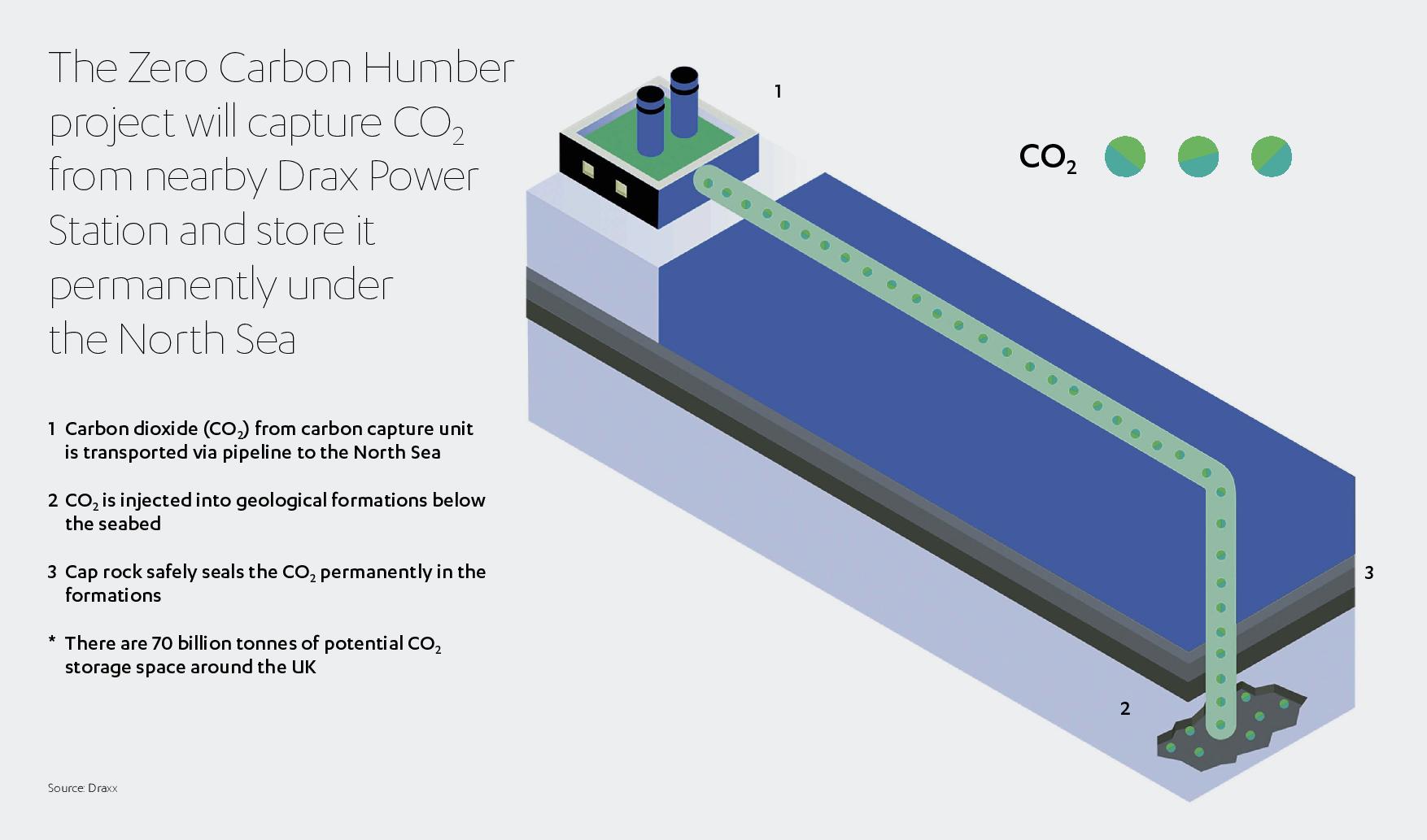
Canada’s Alberta Carbon Trunk Line (ACTL) is the world’s largest capacity pipeline for CO₂. ACTL can transport up to 14.6 million tons of CO₂ per year, “representing approximately 20% of all current oil sands emissions or equal to the impact of capturing the CO₂ from more than 3 million cars in Alberta.” Almost 90% of the 240 km pipeline’s capacity is designed for future CO₂ sources[19].
Carbon capture is critical, but only if we act now
Carbon capture alone will not solve global warming. That will require a concerted global effort to dramatically reduce greenhouse gas emissions by measures such as expanding renewable energy; decarbonizing industry and energy; introducing new mobility systems, rethinking food security; strengthening water systems and redesigning our cities. Nevertheless, it’s hard to imagine meeting zero-carbon targets without the wide-ranging applications and retrofitting potential of CCU, particularly for hard-to-reduce emissions.
The technology already exists to a large extent, but it requires collaboration, coordination and partnerships at the highest levels of industry, commerce, government and community to drive long-term transformation.
Abdul Latif Jameel is committed to overcoming the challenges that lie ahead, not least through our pioneering projects in solar and wind energy through our flagship renewable energy business, Fotowatio Renewable Ventures (FRV), and our fast-growing work to addressing water availability, through Almar Water Solutions. We are also working with other leading global private businesses in the Clean, Renewable and Environmental Opportunities Syndicate to help catalyze both business and government investment into solutions to combat climate change.
Carbon capture may not be the long-term answer. But it could be part of the short-term solution to decarbonizing industry and keeping the global warming goals of the Paris Agreement in sight. Provided government incentives and private investment enable carbon capture to reach scale in the next decade, the technology could prove vital to the green energy transition.
[1] https://climate.nasa.gov/news/2915/the-atmosphere-getting-a-handle-on-carbon-dioxide/
[2] https://www.iea.org/reports/energy-technology-perspectives-2020
[3] https://www.epa.gov/ghgemissions/sources-greenhouse-gas-emissions
[4] How industry can move toward a low-carbon future, McKinsey, July 2018
[5] https://www.iea.org/reports/ccus-in-clean-energy-transitions/a-new-era-for-ccus#growing-ccus-momentum
[6] https://www.scientificamerican.com/article/direct-air-capture-of-CO₂-is-suddenly-a-carbon-offset-option/
[7] The Role of CO2 Storage – Analysis – IEA
[8] https://www.iea.org/reports/ccus-in-clean-energy-transitions/a-new-era-for-ccus
[9] https://news.un.org/en/story/2020/12/1078612
[10] https://www.globalccsinstitute.com/wp-content/uploads/2020/04/45Q_Brief_in_template_LLB.pdf
[11] https://ec.europa.eu/clima/policies/innovation-fund_en
[12] https://www.iea.org/commentaries/is-carbon-capture-too-expensive
[13] https://www.iea.org/fuels-and-technologies/carbon-capture-utilisation-and-storage
[15] https://www.american.edu/sis/centers/carbon-removal/fact-sheet-direct-air-capture.cfm
[16] https://www.equinor.com/en/what-we-do/northern-lights.html
[17] https://www.nsenergybusiness.com/news/norwegian-longship-project/





 1x
1x

 Added to press kit
Added to press kit


